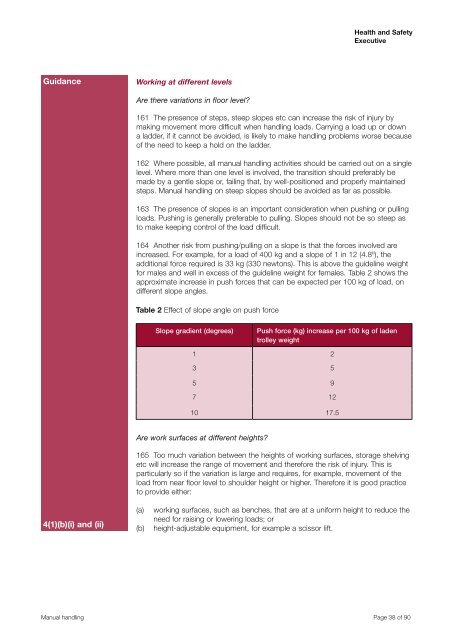Manual Handling Manual Handling Operations Regulations 1992 ...
Manual Handling Manual Handling Operations Regulations 1992 ...
Manual Handling Manual Handling Operations Regulations 1992 ...
You also want an ePaper? Increase the reach of your titles
YUMPU automatically turns print PDFs into web optimized ePapers that Google loves.
Health and Safety<br />
Executive<br />
Guidance<br />
Working at different levels<br />
Are there variations in floor level?<br />
161 The presence of steps, steep slopes etc can increase the risk of injury by<br />
making movement more difficult when handling loads. Carrying a load up or down<br />
a ladder, if it cannot be avoided, is likely to make handling problems worse because<br />
of the need to keep a hold on the ladder.<br />
162 Where possible, all manual handling activities should be carried out on a single<br />
level. Where more than one level is involved, the transition should preferably be<br />
made by a gentle slope or, failing that, by well-positioned and properly maintained<br />
steps. <strong>Manual</strong> handling on steep slopes should be avoided as far as possible.<br />
163 The presence of slopes is an important consideration when pushing or pulling<br />
loads. Pushing is generally preferable to pulling. Slopes should not be so steep as<br />
to make keeping control of the load difficult.<br />
164 Another risk from pushing/pulling on a slope is that the forces involved are<br />
increased. For example, for a load of 400 kg and a slope of 1 in 12 (4.8º), the<br />
additional force required is 33 kg (330 newtons). This is above the guideline weight<br />
for males and well in excess of the guideline weight for females. Table 2 shows the<br />
approximate increase in push forces that can be expected per 100 kg of load, on<br />
different slope angles.<br />
Table 2 Effect of slope angle on push force<br />
Slope gradient (degrees)<br />
Push force (kg) increase per 100 kg of laden<br />
trolley weight<br />
1 2<br />
3 5<br />
5 9<br />
7 12<br />
10 17.5<br />
Are work surfaces at different heights?<br />
165 Too much variation between the heights of working surfaces, storage shelving<br />
etc will increase the range of movement and therefore the risk of injury. This is<br />
particularly so if the variation is large and requires, for example, movement of the<br />
load from near floor level to shoulder height or higher. Therefore it is good practice<br />
to provide either:<br />
4(1)(b)(i) and (ii)<br />
(a)<br />
(b)<br />
working surfaces, such as benches, that are at a uniform height to reduce the<br />
need for raising or lowering loads; or<br />
height-adjustable equipment, for example a scissor lift.<br />
<strong>Manual</strong> handling Page 38 of 90
















